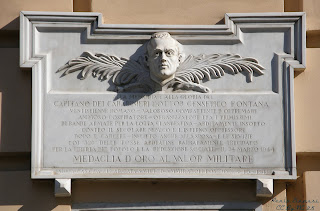
(English) Plaque devoted to Alfredo De Luca, bomber pilot during the second Italo-Ethiopian War, placed on the house where he born, on the 9 August 1909.
De Luca died at Dukan, Ethiopia, 13 August 1936, 3 months after the end of the war. Alfredo De Luca is another almost forgotten name, except for two streets devoted to him: one in Rome, and one in Ischia, in the gulf of Naples.
Posthumously, he was awarded with a Gold Medal of Military Valor (Medaglia d'oro al Valor Militare)
Here a translation of the Golden Medal motivation:
Pilot of a multi-engine aircraft, volunteer in East Africa, during a long operational period he lavished with a dare ardor. (He) was example and a spur for everyone, volunteer everywhere and costantly to accomplish the most difficult and dangerous missions. The main battles to conquest the Empire knew his courage, his accurate acts of an expert bomber pilot and consciously bold. He took part to a bold flight that took the national colors in the Scioa Province, to the enemy capital. He accomplished more than 30 landings in the heart of Dancalia and Aussa, challenging the mortal risks to support an our convoy that was in very difficult conditions. In the sky of battle, in the generous anxiety to validly protect units that was seriously threatened, he lavished without limits in reiterate attacks, offhand to the enemy reaction. Sacrificed heroically his youth for the triumph of our Forces and for the Greatness of the Homeland.
Sky of Ethipia, December 1935 - august 1936; Duckan, 13 august 1936
The plaque, placed probably in 1936, is located in Via XX Settembre 42, and instead of a "fascist style", is realized in the typical style of the plaques placed during the 1870s and the 1880s:letter engraved in black on a plate of white marble, with a frame a grey marble.
The plaque is not well preserved, blackened due the smog.
The only "fascist" reminiscence is the the double notation for the year: gregorian calendar and Fascist Era (the year with roman numerals). This peculiar system of numeration (along the same lines of french revolutionary calendar) starts with the day of March on Rome, was introcude in 1926 and adopted in 1927.
Unusual is the double engraving for the "DE" in De Luca's name.
In the lower right part of the photograph you can notice an old street number plaque in maiolica (tin-glazed pottery) with the old street numeration; few of these street numbers survive in the today Rome.
Here a translation of the plaque inscription:
De Luca died at Dukan, Ethiopia, 13 August 1936, 3 months after the end of the war. Alfredo De Luca is another almost forgotten name, except for two streets devoted to him: one in Rome, and one in Ischia, in the gulf of Naples.
Posthumously, he was awarded with a Gold Medal of Military Valor (Medaglia d'oro al Valor Militare)
Here a translation of the Golden Medal motivation:
Pilot of a multi-engine aircraft, volunteer in East Africa, during a long operational period he lavished with a dare ardor. (He) was example and a spur for everyone, volunteer everywhere and costantly to accomplish the most difficult and dangerous missions. The main battles to conquest the Empire knew his courage, his accurate acts of an expert bomber pilot and consciously bold. He took part to a bold flight that took the national colors in the Scioa Province, to the enemy capital. He accomplished more than 30 landings in the heart of Dancalia and Aussa, challenging the mortal risks to support an our convoy that was in very difficult conditions. In the sky of battle, in the generous anxiety to validly protect units that was seriously threatened, he lavished without limits in reiterate attacks, offhand to the enemy reaction. Sacrificed heroically his youth for the triumph of our Forces and for the Greatness of the Homeland.
Sky of Ethipia, December 1935 - august 1936; Duckan, 13 august 1936
The plaque, placed probably in 1936, is located in Via XX Settembre 42, and instead of a "fascist style", is realized in the typical style of the plaques placed during the 1870s and the 1880s:letter engraved in black on a plate of white marble, with a frame a grey marble.
The plaque is not well preserved, blackened due the smog.
The only "fascist" reminiscence is the the double notation for the year: gregorian calendar and Fascist Era (the year with roman numerals). This peculiar system of numeration (along the same lines of french revolutionary calendar) starts with the day of March on Rome, was introcude in 1926 and adopted in 1927.
Unusual is the double engraving for the "DE" in De Luca's name.
In the lower right part of the photograph you can notice an old street number plaque in maiolica (tin-glazed pottery) with the old street numeration; few of these street numbers survive in the today Rome.
Here a translation of the plaque inscription:
IN THIS HOUSE BORN
LIUTENANT PILOT
ALFREDO DE LUCA
GOLD MEDAL
THE SKIES OF ETHIOPIA
KNEW
HIS HEROIC BOLDNESS
AND SAW
HIS SUPREME SACRIFICE
ROME•9•AUGUST•1909 DVKAN•13•AUGUST•1936 - 14TH (YEAR OF FASCIST ERA)
-
(Italiano) Targa in memoria di Alfredo De Luca, pilota di bombardiere durante la guerra d'Etiopia, situata sulla casa in cui nacque, il 9 agosto 1909.
De Luca morì a Duckan, Etiopia, il 13 agosto 1936, tre mesi dopo la fine della guerra. Un altro dei nomi quasi dimenticati, ad eccetto di due vie a lui intitolate: una a Roma, e l'altra a Ischia.
Postuma, gli venne assegnata la Medaglia d'oro al Valor Militare:
La motivazione per la Medaglia al Valore:
Pilota di apparecchio plurimotore, volontario per l'Africa Orientale, durante un lungo ciclo operativo si prodigò con ardito entusiasmo. Fu di esempio e di sprone a tutti, offrendosi ovunque costantemente per compiere le imprese più rischiose e più ardue. Le principali battaglie impegnate per la conquista dell'Impero conobbero il suo coraggio, la sua azione precisa e formidabile di bombardiere esperto e coscientemente ardito. Partecipò ad un ardito volo che portò i colori nazionali nello Scioa presso la capitale nemica: Compi oltre 30 atterraggi nel cuore della Dancalia e nell'Aussa, sfidando impavido i rischi mortali pur di appoggiare una nostra colonna che si trovava in condizioni particolarmente difficili. Nel cielo della battaglia, nell'ansia generosa di validamente proteggere reparti seriamente minacciati, si prodigava sempre senza limiti in reiterati attacchi, noncurante della reazione nemica. Immolava eroicamente la sua giovinezza per il trionfo delle nostre armi e per la grandezza della Patria: Cielo di Etiopia, dicembre 1935 -agosto 1936; Duckan, 13 agosto 1936
La targa, affissa probabilmente nel 1936, è situata in Via XX Settembre 42, e invece di uno "stile fascista" è realizzata con il tipico stile delle targhe poste tra gli anni '70 ed '80 dell'Ottocento: lettere nere su una lastra di marmo bianco, con una cornice di marmo grigio. La lapide non è ben conservata, ingrigita dallo smog.
L'unica reminiscenza fascista è 'anno con doppia notazione: anno gregoriano ed Era Fascista (L'anno con le cifre romane). Questo peculiare sistema di numerazione (sulla falsariga del calendario rivoluzionario francese) partiva dal giorno della Marcia su Roma, venne introdotto nel 1926, e il suo utilizzo iniziò l'anno successivo.
Inusuale è la doppia incisione per la "DE" del nome di De Luca.
Nella parte inferiore destra della foto si può osservare uno vecchi numeri civici in maiolica, con la vecchia numerazione della via; pochi di questi numeri sopravvivono nella Roma odierna.
De Luca morì a Duckan, Etiopia, il 13 agosto 1936, tre mesi dopo la fine della guerra. Un altro dei nomi quasi dimenticati, ad eccetto di due vie a lui intitolate: una a Roma, e l'altra a Ischia.
Postuma, gli venne assegnata la Medaglia d'oro al Valor Militare:
La motivazione per la Medaglia al Valore:
Pilota di apparecchio plurimotore, volontario per l'Africa Orientale, durante un lungo ciclo operativo si prodigò con ardito entusiasmo. Fu di esempio e di sprone a tutti, offrendosi ovunque costantemente per compiere le imprese più rischiose e più ardue. Le principali battaglie impegnate per la conquista dell'Impero conobbero il suo coraggio, la sua azione precisa e formidabile di bombardiere esperto e coscientemente ardito. Partecipò ad un ardito volo che portò i colori nazionali nello Scioa presso la capitale nemica: Compi oltre 30 atterraggi nel cuore della Dancalia e nell'Aussa, sfidando impavido i rischi mortali pur di appoggiare una nostra colonna che si trovava in condizioni particolarmente difficili. Nel cielo della battaglia, nell'ansia generosa di validamente proteggere reparti seriamente minacciati, si prodigava sempre senza limiti in reiterati attacchi, noncurante della reazione nemica. Immolava eroicamente la sua giovinezza per il trionfo delle nostre armi e per la grandezza della Patria: Cielo di Etiopia, dicembre 1935 -agosto 1936; Duckan, 13 agosto 1936
La targa, affissa probabilmente nel 1936, è situata in Via XX Settembre 42, e invece di uno "stile fascista" è realizzata con il tipico stile delle targhe poste tra gli anni '70 ed '80 dell'Ottocento: lettere nere su una lastra di marmo bianco, con una cornice di marmo grigio. La lapide non è ben conservata, ingrigita dallo smog.
L'unica reminiscenza fascista è 'anno con doppia notazione: anno gregoriano ed Era Fascista (L'anno con le cifre romane). Questo peculiare sistema di numerazione (sulla falsariga del calendario rivoluzionario francese) partiva dal giorno della Marcia su Roma, venne introdotto nel 1926, e il suo utilizzo iniziò l'anno successivo.
Inusuale è la doppia incisione per la "DE" del nome di De Luca.
Nella parte inferiore destra della foto si può osservare uno vecchi numeri civici in maiolica, con la vecchia numerazione della via; pochi di questi numeri sopravvivono nella Roma odierna.
IN QVESTA CASA NACQVE
IL TENENTE PILOTA
ALFREDO DE LVCA
MEDAGLIA D'ORO
I CIELI DI ETIOPIA
CONOBBERO
IL SVO EROICO ARDIMENTO
E VIDERO
IL SVO SVPREMO SACRIFICIO
ROMA•9•VIII•1909 DVKAN•13•VIII•1936 - XIV
Collegamenti - Links
IL TENENTE PILOTA
ALFREDO DE LVCA
MEDAGLIA D'ORO
I CIELI DI ETIOPIA
CONOBBERO
IL SVO EROICO ARDIMENTO
E VIDERO
IL SVO SVPREMO SACRIFICIO
ROMA•9•VIII•1909 DVKAN•13•VIII•1936 - XIV
- http://www.quirinale.it/qrnw/statico/onorificenze/decorato.asp?id=13760&ono=20
- http://www.larassegnadischia.it/Dizionario/voci/lettd.html





